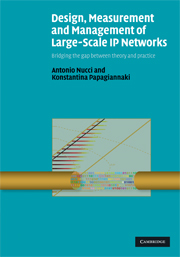 Design, Measurement and Management of Large-Scale IP Networks
Design, Measurement and Management of Large-Scale IP Networks Book contents
- Frontmatter
- Contents
- Acknowledgments
- 1 Introduction
- 2 Background and context
- I Network monitoring and management
- 3 The need for monitoring in ISP network design and management
- 4 Understanding through-router delay
- 5 Traffic matrices: measurement, inference and modeling
- II Network design and traffic engineering
- III From bits to services
- Appendix A How to link original and measured flow characteristics when packet sampling is used: bytes, packets and flows
- Appendix B Application-specific payload bit strings
- Appendix C BLINC implementation details
- Appendix D Validation of direction-conforming rule
- References
- Index
4 - Understanding through-router delay
from I - Network monitoring and management
Published online by Cambridge University Press: 05 September 2012
- Frontmatter
- Contents
- Acknowledgments
- 1 Introduction
- 2 Background and context
- I Network monitoring and management
- 3 The need for monitoring in ISP network design and management
- 4 Understanding through-router delay
- 5 Traffic matrices: measurement, inference and modeling
- II Network design and traffic engineering
- III From bits to services
- Appendix A How to link original and measured flow characteristics when packet sampling is used: bytes, packets and flows
- Appendix B Application-specific payload bit strings
- Appendix C BLINC implementation details
- Appendix D Validation of direction-conforming rule
- References
- Index
Summary
End-to-end packet delay is an important metric to measure in networks, both from the network operation and application performance points of view. An important component of this delay is the time for packets to traverse the different switching elements along the path. This is particularly important for network providers, who may have SLAs specifying allowable values of delay across the domains they control. A fundamental building block of the path delay experienced by packets in IP networks is the delay incurred when passing through a single IP router. In this chapter we go through a detailed description of the operations performed on an IP packet when transitting an IP router and measurements of their respective time to completion, as collected on an operational high-end router. Our discussion focuses on the most commonly found router architecture, which is based on a cross-bar switch.
To quantify the individual components of through-router delay, we present results obtained through a unique set of measurements that captures all packets transmitted on all links of an operational access router for a duration of 13 hours. Using this data set, this chapter studies the behavior of those router links that experienced congestion and reports on the magnitude and temporal structure of the resulting packet delays. Such an analysis reveals that cases of overload in operational IP links in the core of an IP network do exist, but tend to be of small magnitude and low frequency.
Information
- Type
- Chapter
- Information
- Design, Measurement and Management of Large-Scale IP NetworksBridging the Gap Between Theory and Practice, pp. 47 - 84Publisher: Cambridge University PressPrint publication year: 2008